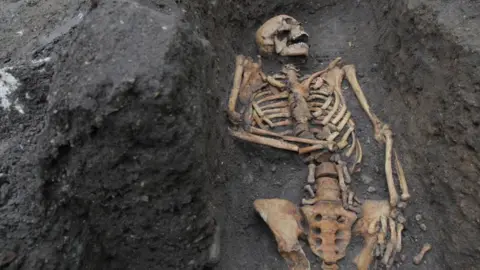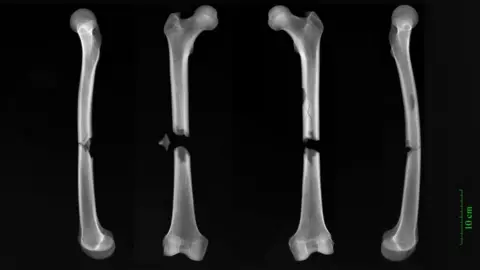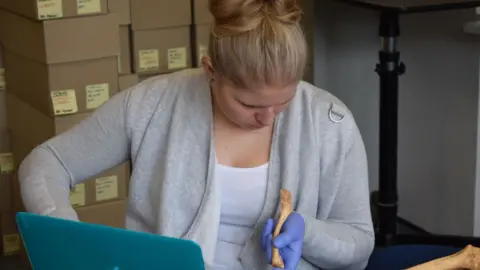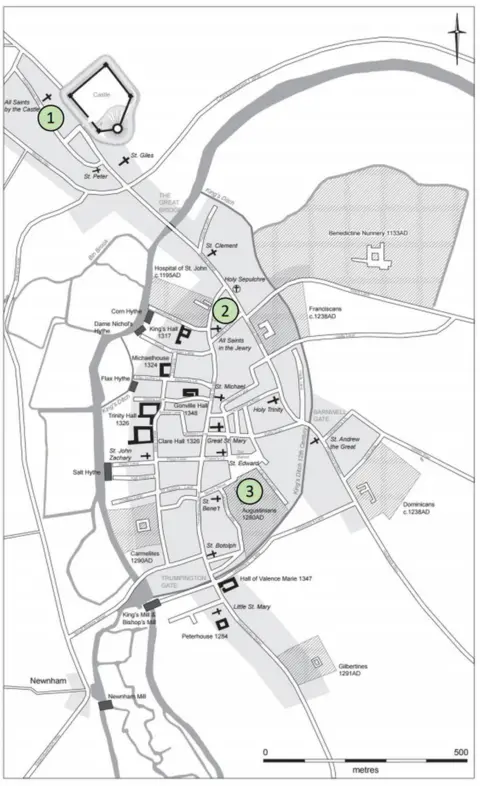Medieval Cambridge skeletons reveal injuries to manual labourers
 Nick Saffell/University of Cambridge/PA Wire
Nick Saffell/University of Cambridge/PA Wire X-rays of more than 300 graveyard skeletons have revealed the high levels of injuries suffered by medieval manual labourers.
Skeletons from three local graveyards were studied by archaeologists from Cambridge University.
They found 44% of working people in a parish cemetery had bone fractures, compared to 32% in a wealthier one, and 27% in a cemetery for the infirm.
The study had "helped gauge the hazards of daily life", the team said.
The burial sites were within what is now the historic city centre, and the 314 skeletons were at least 25% complete.
They dated from the 10th to 14th Centuries when Cambridge was primarily a provincial town of artisans, merchants and farmhands, with scholars arriving in 1209.
The research catalogued the nature of every break and fracture on 75 skeletons from an Augustinian friary which buried wealthy donors alongside clergy, and 155 buried at the charitable Hospital of St John the Evangelist, where the infirm and destitute were interred.
However, they found the highest number of fractures on the 84 skeletons from the parish graveyard, called All Saints by the Castle.
"We can see that ordinary working folk had a higher risk of injury compared to the friars and their benefactors or the more sheltered hospital inmates," said Dr Jenna Dittmar, from the university's Department of Archaeology.
 Dr Jenna Dittmar/PA Wire
Dr Jenna Dittmar/PA Wire University of Cambridge/PA Wire
University of Cambridge/PA WireWorking life often began at the age of 12 and she said those buried at the parish site would have been involved in "long hours doing heavy manual labour" including stonemasonry, blacksmithing or "bone-crushing work in the fields".
 Cambridge Archaeological Unit/St John's College/PA
Cambridge Archaeological Unit/St John's College/PAOne woman buried at the All Saints cemetery showed signs of possible domestic abuse, they said, with rib, jaw, foot and vertebrae fractures that had healed before her death.
However, the most severe injuries were found on a friar, whose thigh bones were both broken in what they suspect to have been a cart accident.
Dr Dittmar said today's clinicians would be familiar with such injuries - on those hit by vehicles.
Another friar showed signs of defensive fractures to his arms and blunt force trauma to his skull, which the team believes were probably as a result of being attacked.
"We can see this inequality recorded on the bones of medieval Cambridge residents," Dr Dittmar said.
"However, severe trauma was prevalent across the social spectrum."
 Vicki Herring/University of Cambridge
Vicki Herring/University of Cambridge
Find BBC News: East of England on Facebook, Instagram and Twitter. If you have a story suggestion email [email protected]
